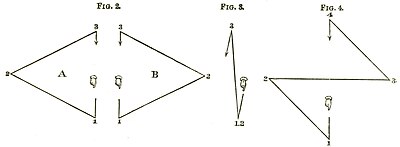of even two beats in a bar; and, in these cases, a single down-beat only is used, the upward motion of the Conductor's hand passing unnoticed, in consequence of its rapidity, as at (B).
When three beats are needed in the bar, the custom is, in England, to beat once downwards, once to the left, and once upwards, as at (A) in Fig. 2. In France, the same system is used in the Concert-room; but in the Theatre it is usual to direct the second beat to the right, as at B, on the ground that the Conductor's Baton is thus rendered more easily visible to performers seated behind him. Both plans have their advantages and their disadvantages; but the fact that motions directed downwards, or towards the right, are always understood to indicate either primary or secondary accents, weighs strongly in favour of the English method.

But in very rapid Movements such as we find in some of Beethoven's Scherzos it is better to indicate 3-4 or 3-8 Time by a single downbeat, like those employed in very rapid 2-4; only that, in this case, the upward motion which the Conductor necessarily makes in preparation for the downward beat which is to follow must be made to correspond as nearly as possible with the third Crotchet or Quaver of the Measure, as in Fig. 3.
When four beats are needed in the bar, the first is directed downwards; the second towards the left; the third towards the right; and the fourth upwards. (Fig. 4.)

It is not possible to indicate more than four full beats in a bar, conveniently. But it is easy to indicate eight in a bar, by supplementing each full beat by a smaller one in the same direction, as at (A) in Fig. 5; or, by the same means, to beat six Quavers in a bar of very slow 3-4 Time, as at (B), or (C).
Compound Times, whether Common or Triple, may be beaten in two ways. In moderately quick Movements, they may be indicated by the same number of beats as the Simple Times from which they are derived: e.g. 6-8 Time may be beaten like 2-4; 6-4 like Alla Cappella; 12-8 like 4-4; 9-8 like 3-4; 9-16 like 3-8, etc., etc. But, in slower Movements, each constituent of the Compound Measure must be indicated by a triple motion of the Baton; that is to say, by one full beat, followed by two smaller ones, in the same direction; 6-4 or 6-8 being taken as at (A) in Fig. 6; 9-4 or 9-8 as at (B); and 12-8 as at (C). The advantage of this plan is, that in all cases the greater divisions of the bar are indicated by full beats, and the subordinate ones by half-beats.
For the anomalous rhythmic combinations with five or seven beats in the bar, it is difficult to lay down a law the authority of which is sufficiently obvious to ensure its general acceptation. Two very different methods have been recommended; and both have their strong and their weak points.
One plan is, to beat each bar of Quintuple
